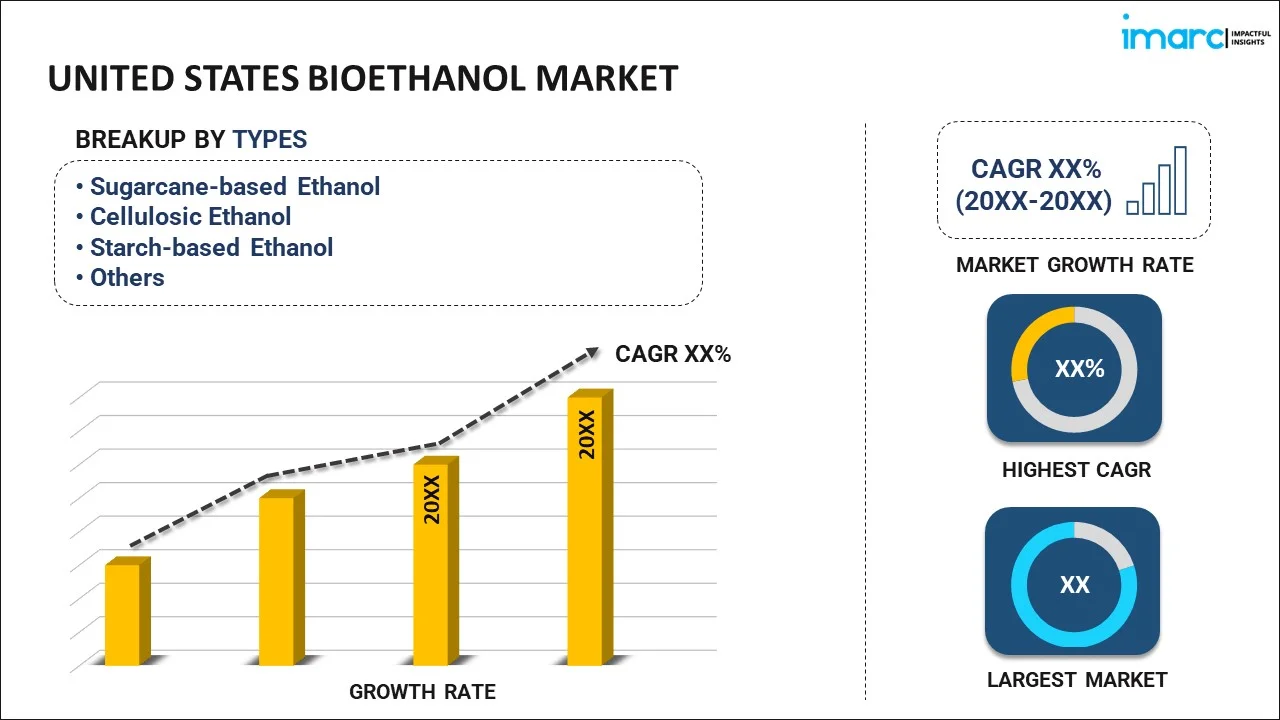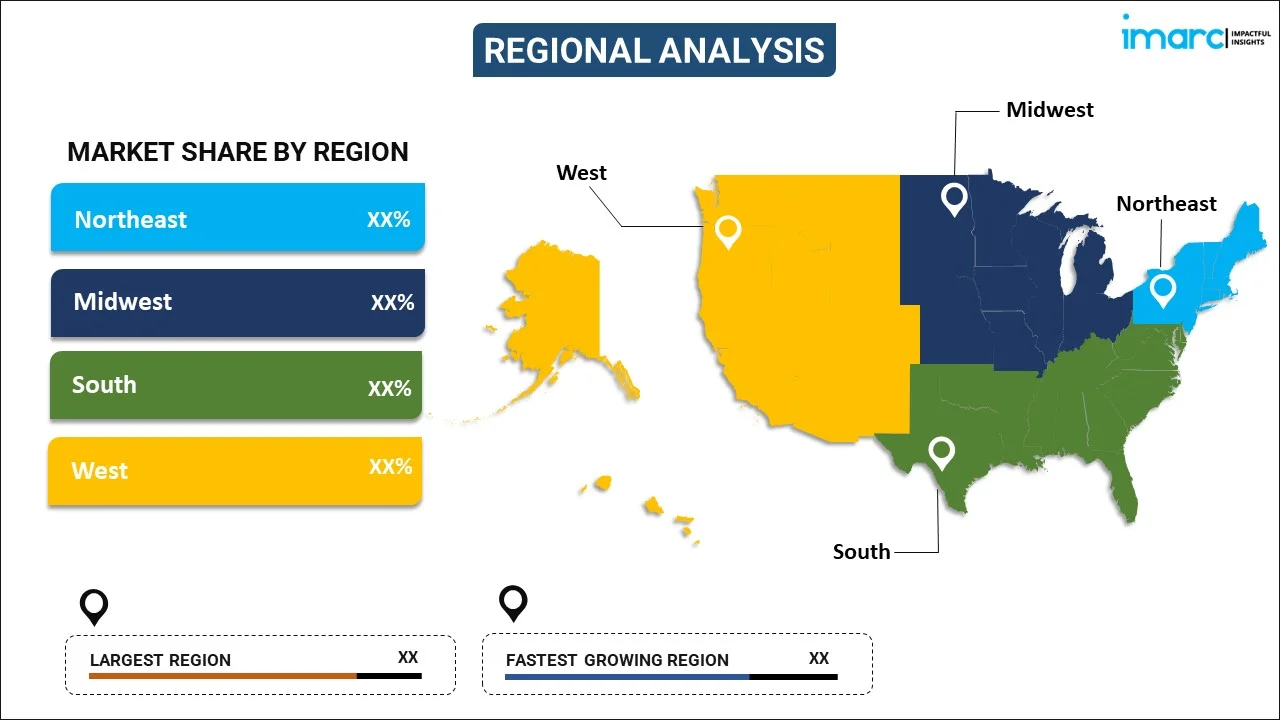
United States Bioethanol Market Report by Types (Sugarcane-based Ethanol, Cellulosic Ethanol, Starch-based Ethanol, and Others), Fuel Blend (E10, E20 and E25, E70 and E75, E85, and Others), Generation (First Generation, Second Generation, Third Generation), End Use Industry (Automotive and Transportation, Power Generation, Pharmaceutical, Food and Beverage, Cosmetics and Personal Care, and Others), and Region 2025-2033
Market Overview:
United States bioethanol market size reached USD 2.64 Billion in 2024. Looking forward, IMARC Group expects the market to reach USD 4.34 Billion by 2033, exhibiting a growth rate (CAGR) of 5.08% during 2025-2033. The development of eco-friendly fuel alternatives, on account of the rising consumer environmental concerns, is primarily driving the market growth across the country.
|
Report Attribute
|
Key Statistics
|
|---|---|
|
Base Year
|
2024
|
|
Forecast Years
|
2025-2033
|
|
Historical Years
|
2019-2024
|
|
Market Size in 2024
|
USD 2.64 Billion |
|
Market Forecast in 2033
|
USD 4.34 Billion |
| Market Growth Rate 2025-2033 | 5.08% |
United States Bioethanol Market Analysis:
- Major Market Drivers: The market is led by federal blending requirements, positive renewable fuel policies, and increasing consumer demand for green substitutes. Increasing availability of feedstocks, especially corn and cellulosic biomass, along with improving processing efficiency, continues to strengthen bioethanol's position in national energy security.
- Key Market Trends: Increasing investment in second-generation bioethanol, based on agricultural waste and non-food biomass, emphasizes sustainability imperatives. Harnessing advanced technologies is enhancing yields and lowering carbon intensity. Transport sector drive for decarbonization further enhances bioethanol's role in renewable energy policies in numerous regional and national markets.
- Competitive Landscape: Competition in the industry mirrors infrastructure development, technology improvements, and strategic partnerships. Manufacturers are putting investments into innovation to enhance sustainability and export competitiveness. Policy support and global trade partnerships are fostering greater adoption, creating a dynamic market environment where efficiency and scale are still essential drivers of success.
- Challenges and Opportunities: Unstable feedstock prices and infrastructure needs are issues of concern, but global decarbonization targets bring major opportunity. Increasing export potential and domestic demand for renewable fuel increase resilience in the sector. These trends are expected to increasingly reinforce the United States bioethanol market share during forecast periods.
Bioethanol, a clear and colorless liquid derived from biomass through hydrolysis and sugar fermentation or the chemical reaction of ethylene with steam, stands as an environmentally friendly alternative to conventional fuels. Notably biodegradable and less toxic, it mitigates environmental pollution, positioning itself as a prominent substitute for traditional fuels in road transport vehicles. Its seamless blending with petrol without necessitating modifications to engine designs yields a reduction in both greenhouse gas (GHG) emissions and air pollution. The current surge in research and development activities, particularly in the production of bioethanol fuel using municipal solid waste, is augmenting the demand for this sustainable energy source across the country.
United States Bioethanol Market Trends:
Growing Integration of Bioethanol into Transportation Fuels
Increased integration of bioethanol into the fuel supply chain is transforming the energy landscape throughout the United States. With increasing focus on reducing carbon emissions, bioethanol blends are increasingly being integrated into gasoline, providing a cleaner, more renewable fuel option. Renewable fuel-supporting policies by governments have further boosted this trend, making bioethanol a notable stakeholder in transportation energy demands. The change also demonstrates consumers' desire for affordable and environmentally friendly alternatives, pushing new development in refining and blending operations. Here, the focus on low-emission freight has facilitated a conducive setting for higher ethanol blend penetration. This aspect is an important driver of enhancing United States bioethanol market size, with continuous investments in blending infrastructure and favorable legislation providing long-term momentum for the industry.
Increased Role in Industrial and Chemical Uses
Aside from its historical use as a fuel component for transportation, bioethanol is growing in importance in industrial and chemical uses throughout the United States. It is being used more widely as a solvent, in pharmaceuticals, personal care products, and as feedstock for bio-based chemicals, further contributing to a shift towards cleaner production processes. This diversification is important because it decreases the dependence on fossil fuel–based raw materials and creates doors for green industrial solutions. Further, the flexibility of bioethanol in blending, formulation, and chemical synthesis renders it a manufacturer's choice of renewable input. Increased demand for environmentally friendly industrial products reinforces its prospects in several downstream industries. This expansion supports United States bioethanol market growth by noting the fuel to be able to extend its purpose beyond energy, while backing national goals of encouraging cleaner industries and lowering the carbon intensity of manufacturing.
Improvements in Feedstock and Production Technologies
The United States is experiencing quick advancement in feedstock use and production technologies for bioethanol. Corn is still the most prevalent raw material, but increasing work and use of cellulosic feedstocks, such as agricultural waste and non-food biomass crops, are being developed. These developments promote sustainability, minimize use of food-based crops, and increase the range of possible production bases. In addition, technological advancements in fermentation and enzyme efficiency are making higher production levels and lower costs possible, enhancing the competitiveness of the sector. This development also facilitates energy diversification and rural growth, meeting environmental and economic purposes. Increasing focus on next-generation biofuels is at the forefront of making the long-term use of bioethanol in a dynamic energy mix possible. These developments are at the heart of making United States bioethanol market analysis stronger, with innovation being the basis for a more efficient, diversified, and cleaner fuel industry throughout the country.
United States Bioethanol Market Segmentation:
IMARC Group provides an analysis of the key trends in each segment of the market, along with forecasts at the country level for 2025-2033. Our report has categorized the market based on type, fuel blend, generation, and end use industry.
Type Insights:

To get more information on this market, Request Sample
- Sugarcane-based Ethanol
- Cellulosic Ethanol
- Starch-based Ethanol
- Others
The report has provided a detailed breakup and analysis of the market based on the type. This includes sugarcane-based ethanol, cellulosic ethanol, starch-based ethanol, and others.
Fuel Blend Insights:
- E10
- E20 and E25
- E70 and E75
- E85
- Others
A detailed breakup and analysis of the market based on the fuel blend have also been provided in the report. This includes E10, E20 and E25, E70 and E75, E85, and others.
Generation Insights:
- First Generation
- Second Generation
- Third Generation
The report has provided a detailed breakup and analysis of the market based on the generation. This includes first generation, second generation, and third generation.
End Use Industry Insights:
- Automotive and Transportation
- Power Generation
- Pharmaceutical
- Food and Beverage
- Cosmetics and Personal Care
- Others
A detailed breakup and analysis of the market based on the end use industry have also been provided in the report. This includes automotive and transportation, power generation, pharmaceutical, food and beverage, cosmetics and personal care, and others.
Regional Insights:

- Northeast
- Midwest
- South
- West
The report has also provided a comprehensive analysis of all the major regional markets, which include Northeast, Midwest, South, and West.
Competitive Landscape:
The market research report has also provided a comprehensive analysis of the competitive landscape. Competitive analysis such as market structure, key player positioning, top winning strategies, competitive dashboard, and company evaluation quadrant has been covered in the report. Also, detailed profiles of all major companies have been provided.
Latest News and Developments:
- In August 2024, Verbio AG commenced commercial ethanol production in its Nevada biorefinery the first U.S. industrial-scale facility integrating renewable natural gas and bioethanol. With an annual capacity of 60 million gallons of ethanol, the project enhances regional grower partnerships and realizes substantial regional economic gains.
- In May 2024, Verbio started up the expansion of its South Bend, Indiana ethanol plant into a full biorefinery with joint bioethanol and biomethane production. Supported by an investment of \\$230 million, the project is expected to be completed by 2026, boosting renewable energy capacity and supporting the company's U.S. growth strategy.
United States Bioethanol Market Report Coverage:
| Report Features | Details |
|---|---|
| Base Year of the Analysis | 2024 |
| Historical Period | 2019-2024 |
| Forecast Period | 2025-2033 |
| Units | Billion USD |
| Scope of the Report | Exploration of Historical Trends and Market Outlook, Industry Catalysts and Challenges, Segment-Wise Historical and Future Market Assessment:
|
| Types Covered | Sugarcane-based Ethanol, Cellulosic Ethanol, Starch-based Ethanol, Others |
| Fuel Blends Covered | E10, E20 and E25, E70 and E75, E85, Others |
| Generations Covered | First Generation, Second Generation, Third Generation |
| End Use Industries Covered | Automotive and Transportation, Power Generation, Pharmaceutical, Food and Beverage, Cosmetics and Personal Care, Others |
| Regions Covered | Northeast, Midwest, South, West |
| Customization Scope | 10% Free Customization |
| Post-Sale Analyst Support | 10-12 Weeks |
| Delivery Format | PDF and Excel through Email (We can also provide the editable version of the report in PPT/Word format on special request) |
Key Benefits for Stakeholders:
- IMARC’s industry report offers a comprehensive quantitative analysis of various market segments, historical and current market trends, market forecasts, and dynamics of the United States bioethanol market from 2019-2033.
- The research report provides the latest information on the market drivers, challenges, and opportunities in the United States bioethanol market.
- Porter's five forces analysis assist stakeholders in assessing the impact of new entrants, competitive rivalry, supplier power, buyer power, and the threat of substitution. It helps stakeholders to analyze the level of competition within the United States bioethanol industry and its attractiveness.
- Competitive landscape allows stakeholders to understand their competitive environment and provides an insight into the current positions of key players in the market.
Key Questions Answered in This Report
The bioethanol market in the United States was valued at USD 2.64 Billion in 2024.
The United States bioethanol market is projected to exhibit a CAGR of 5.08% during 2025-2033, reaching a value of USD 4.34 Billion by 2033.
The United States bioethanol market is driven by rising demand for cleaner fuels, supportive government blending mandates, and efforts to reduce greenhouse gas emissions. Increasing corn production, technological advancements in biofuel processing, and growing adoption of bioethanol as a cost-effective gasoline additive further strengthen its market growth.
Need more help?
- Speak to our experienced analysts for insights on the current market scenarios.
- Include additional segments and countries to customize the report as per your requirement.
- Gain an unparalleled competitive advantage in your domain by understanding how to utilize the report and positively impacting your operations and revenue.
- For further assistance, please connect with our analysts.
 Request Customization
Request Customization
 Speak to an Analyst
Speak to an Analyst
 Request Brochure
Request Brochure
 Inquire Before Buying
Inquire Before Buying




.webp)




.webp)












